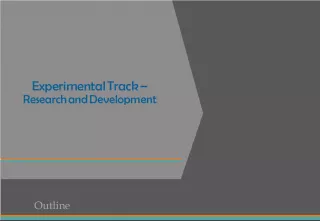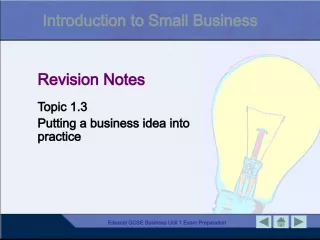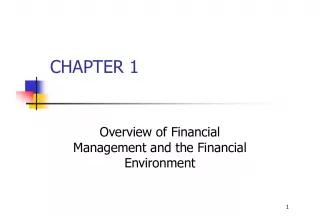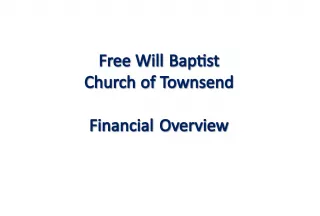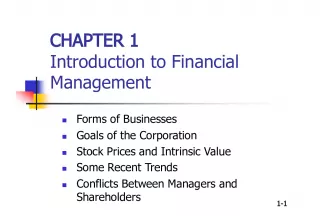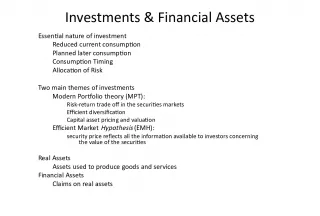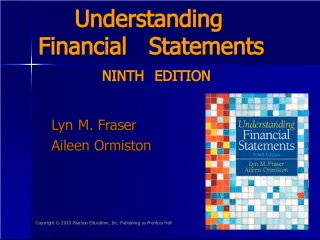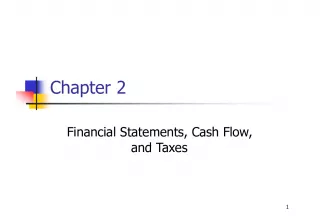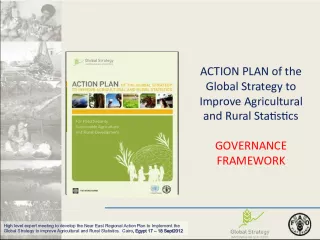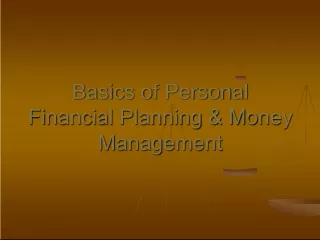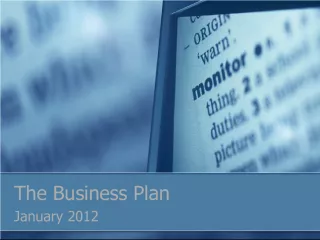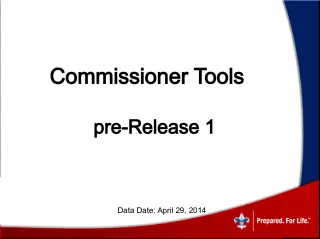"Overview and Objectives of a Financial Plan"


This chapter, copyrighted by Pearson Education Inc. in 2004, introduces the subject of personal finance and identifies the key components of a financial plan. The objectives of the chapter are
- Uploaded on | 1 Views
-
 rick
rick
About "Overview and Objectives of a Financial Plan"
PowerPoint presentation about '"Overview and Objectives of a Financial Plan"'. This presentation describes the topic on This chapter, copyrighted by Pearson Education Inc. in 2004, introduces the subject of personal finance and identifies the key components of a financial plan. The objectives of the chapter are. The key topics included in this slideshow are . Download this presentation absolutely free.
Presentation Transcript
Slide1copyright ©2004 pearson education, inc. all rights reserved.Chapter 1 Overview of a Financial Plan
Slide2copyright ©2004 pearson education, inc. all rights reserved.1-2 Chapter Objectives • Introduce the subject of personal finance • Identify the key components of a financial plan • Outline the steps involved in developing your financial plan
Slide3copyright ©2004 pearson education, inc. all rights reserved.1-3 Definitions • Personal finance: the process of planning your spending, financing, and investing so as to optimize your financial situation • Personal financial plan: a plan that specifies your financial goals and describes the spending, financing, and investing plans that are intended to achieve those goals
Slide4copyright ©2004 pearson education, inc. all rights reserved.1-4 Definitions • Opportunity cost: what you give up as a result of a decision
Slide5copyright ©2004 pearson education, inc. all rights reserved.1-5 How You Benefit From An Understanding of Personal Finance • Make your own financial decisions – Every spending decision has an opportunity cost • Judge the advice of financial advisors – Make informed decisions • Become a financial advisor – Many career opportunities available
Slide6copyright ©2004 pearson education, inc. all rights reserved.1-6 Components of a Financial Plan • Budgeting and tax planning • Managing your liquidity • Financing your large purchases • Protecting your assets and income (insurance) • Investing your money • Planning your retirement and estate
Slide7copyright ©2004 pearson education, inc. all rights reserved.1-7 A Plan for Your Budgeting and Tax Planning • Budget planning: The process of forecasting future expenses and savings • Evaluate your current financial position – Assets: what you own – Liabilities: what you owe – Net worth: the value of what you own minus the value of what you owe
Slide8copyright ©2004 pearson education, inc. all rights reserved.1-8 Budgeting and Tax Planning Exhibit 1.1: How a Budget Affects Savings
Slide9copyright ©2004 pearson education, inc. all rights reserved.1-9 A Plan to Manage Your Liquidity • Liquidity: access to funds to cover any short-term cash deficiencies • Money management: decisions regarding how much money to retain in a liquid form and how to allocate the funds among short-term investment instruments
Slide10copyright ©2004 pearson education, inc. all rights reserved.1-10 A Plan to Manage Your Liquidity • Credit management: decisions regarding how much credit to obtain to support your spending and which sources of credit to use
Slide11copyright ©2004 pearson education, inc. all rights reserved.1-11 Managing Your Liquidity Exhibit 1.2: Managing Your Liquidity
Slide12copyright ©2004 pearson education, inc. all rights reserved.1-12 A Plan for Your Financing • Loans often needed for large expenditures – College tuition, car, house • Managing loans – How much can you afford to borrow? – Determining maturity of the loan – Selecting a loan with a competitive interest rate
Slide13copyright ©2004 pearson education, inc. all rights reserved.1-13 Financing Your Large Purchases Exhibit 1.3: Financing Process
Slide14copyright ©2004 pearson education, inc. all rights reserved.1-14 A Plan for Your Investing • Funds not needed for liquidity can be invested – Stocks, bonds, mutual funds, real estate • All investments have some level of risk • Risk: uncertainty surrounding the potential return on an investment
Slide15copyright ©2004 pearson education, inc. all rights reserved.1-15 A Plan for Your Retirement and Estate • This includes insurance planning, retirement planning, and estate planning – Retirement planning: determining how much money should be set aside each year for retirement and how those funds should be invested – Estate planning: determining how your wealth will be distributed before or upon your death
Slide16copyright ©2004 pearson education, inc. all rights reserved.1-16 Exhibit 1.4: Components of Your Financial Plan Components of Your Financial Plan
Slide17copyright ©2004 pearson education, inc. all rights reserved.1-17 How the Text Organization Relates to the Financial Plan’s Components • Each of the six parts of the text covers one specific component of the financial plan • An effective financial plan enhances net worth and builds wealth • Follow the steps to a complete financial plan at the end of the school term
Slide18copyright ©2004 pearson education, inc. all rights reserved.1-18 How the Text Organization Relates to the Financial Plan’s Components • How the components relate to your cash flows – Cash inflows are cash that you receive – Cash outflows are cash that you spend – Budgeting balances income and spending – Liquidity deals with cash excesses or shortages
Slide19copyright ©2004 pearson education, inc. all rights reserved.1-19 How the Text Organization Relates to the Financial Plan’s Components – Financing focuses on obtaining cash for large purchases or repaying loans – Protect assets and income by using cash for insurance and retirement – Investing uses cash to build wealth
Slide20copyright ©2004 pearson education, inc. all rights reserved.1-20 How Financial Planning Relates to Cash Flow Exhibit 1.6: How Financial Planning Affects Your Cash Flows
Slide21copyright ©2004 pearson education, inc. all rights reserved.1-21 Developing the Financial Plan • Step 1. Establish Your Financial Goals – Types of goals • Car, home, college, wealth, charity – Set realistic goals • Stronger likelihood of reaching goals – Timing of goals • Short term (within one year) • Intermediate (between 1–5 years) • Long term (beyond five years)
Slide22copyright ©2004 pearson education, inc. all rights reserved.1-22 Developing the Financial Plan • Step 2. Consider Your Current Financial Position – How your future financial position is tied to your education • Consider your skills, interests, and career paths – How your future financial position is tied to your career choice • Choose a career that will be enjoyable and suit your skills
Slide23copyright ©2004 pearson education, inc. all rights reserved.1-23 Developing the Financial Plan
Slide24copyright ©2004 pearson education, inc. all rights reserved.1-24 Developing the Financial Plan
Slide25copyright ©2004 pearson education, inc. all rights reserved.1-25 Developing the Financial Plan • Step 3. Identify and Evaluate Alternative Plans That Could Achieve Your Goals – Plans could be conservative or aggressive • Step 4. Select and Implement the Best Plan for Achieving Your Goals – The Internet has valuable financial planning information
Slide26copyright ©2004 pearson education, inc. all rights reserved.1-26 Developing the Financial Plan • Focus on Ethics: Personal Financial Advice – Your objective is to get the best advice appropriate to your needs – Be wary of unethical behavior • Difficult to discern – Be wary of incompetent advice • Be alert, ask questions, carefully consider advice
Slide27copyright ©2004 pearson education, inc. all rights reserved.1-27 Developing the Financial Plan • Step 5. Evaluate Your Financial Plan – Keep plan in an accessible place and monitor your progress • Step 6. Revise Your Financial Plan – Change plan as financial condition and financial goals change
Slide28copyright ©2004 pearson education, inc. all rights reserved.1-28 How the Internet Facilitates Financial Planning • The Internet provides information on all aspects of financial planning – Bank deposit rates – Prices of cars and homes – Financing rates – Prices of investments – Insurance premiums
Slide29copyright ©2004 pearson education, inc. all rights reserved.1-29 How the Internet Facilitates Financial Planning • Provides updated information on all parts of your financial plan – Current tax rates and regulations – Investment performances – Online calculators
Slide30copyright ©2004 pearson education, inc. all rights reserved.1-30 How the Internet Facilitates Financial Planning 1.1 Financial Planning Online: Should You Pursue a Career in Financial Planning?
Slide31copyright ©2004 pearson education, inc. all rights reserved.1-31 Financial Planning Online: Financial Planning Tools for You • Go to http://finance.yahoo.com • This website provides much information and many tools that can be used for all aspects of financial planning. • It also provides information for creating retirement plans and wills.
Slide32copyright ©2004 pearson education, inc. all rights reserved.1-32 Integrating Key Concepts
Slide33copyright ©2004 pearson education, inc. all rights reserved.1-33 Looking Ahead • Part 1: Financial Planning Tools – Chapter 1 showed an overview of a financial plan – Chapter 2 teaches personal financial statements – Chapter 3 teaches time value of money – Chapter 4 teaches tax planning • Part 2: Liquidity Management • Part 3: Financing • Part 4: Protecting Your Wealth • Part 5: Investing • Part 6: Retirement and Estate Planning

